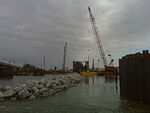Patrol torpedo boat PT-305
1943 shipsMuseum ships in LouisianaPT boatsPatrol vessels of the United States NavyShip infoboxes without an image ... and 2 more
United States Navy in the 20th centuryWorld War II patrol vessels of the United States

PT-305, also known as USS Sudden Jerk, was a 78 foot Higgins PT-200-class motor torpedo boat that served with Motor Torpedo Boat Squadron 22, assigned to the Mediterranean, based at Bastia, Corsica, and St. Tropez, France, where it participated in Allied invasions.After World War II, the boat operated as a tour boat in New York City and as an oyster boat in the Chesapeake Bay. It was recovered and has been restored to its 1944 condition and is on display at The National WWII Museum in New Orleans.
Excerpt from the Wikipedia article Patrol torpedo boat PT-305 (License: CC BY-SA 3.0, Authors, Images).Patrol torpedo boat PT-305
Stars and Stripes Boulevard, New Orleans
Geographical coordinates (GPS) Address Nearby Places Show on map
Geographical coordinates (GPS)
| Latitude | Longitude |
|---|---|
| N 30.040815 ° | E -90.01317 ° |
Address
South Shore Harbor Marina
Stars and Stripes Boulevard
70126 New Orleans
Louisiana, United States
Open on Google Maps







